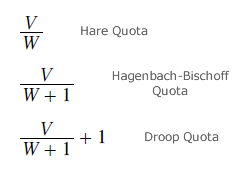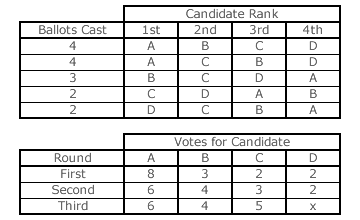Comparisons: Single Transferable Vote 1
Description of the Single Transferable Vote
The Single Transferable Vote (STV) is a preferential voting system that still employs the same ranked ballots as used in the previous single-winner ones. Like the Alternative Vote, the STV algorithm is based on the transfer of votes rather than on weighted preferences or on pairwise comparisons. Indeed, with just a single winner, STV equates to the Alternative Vote.
To win in an STV election, a candidate must have a tally that equals or exceeds a specified quota. There are various different quotas to choose from but each is a function of the number of voters (V) and the number of seats/winners (W). The chosen quota ensures that only W out of the N candidates can reach this threshold; hence preventing more winners than seats. For example, with two winners (W = 2), a candidate must get over one third of the vote (V/3) at the very least and no more than two candidates can achieve such a tally. In the first round, only first preferences are counted for each candidate.
At any stage of the count, a candidate is elected when their tally meets or exceeds the quota. Any votes in excess of the quota are surplus and are transferred instead to the second (or next highest) preferred candidates in proportion to the number of such preferences for each candidate. If no new candidate reaches the quota in a given round, the one with the lowest tally is eliminated. The votes for this candidate are then transferred to the second (or next highest) preferred candidates. This process continues until all the seats are filled. For a more detailed and comprehensive description of the Single Transferable Vote, please visit the voting system section of Wikipedia or another reference source.
Single Transferable Vote Quotas

The Hare quota is simply the number of voters (V) divided by the number of seats/winners (W). Most STV elections today use the Droop quota instead. The Hagenbach-Bischoff quota is only a single vote less than the Droop one so they only very rarely produce different results. All three quotas are defined opposite.
However, when dividing by V to obtain the vote (tally) share quota for each winner, the Hare and Hagenbach-Bischoff share thresholds become 1/W and 1/(W+1) respectively. Unlike for the Droop quota, the absolute number of voters is now irrelevant and this enables much of the later detailed analysis in this chapter. For a specific practical STV election, it is the absolute (and not the relative) quota that is used. Hence, for the example that follows, the usual Droop quota is employed.
Single Transferable Vote Election Example

The ranked ballots cast by voters in an example four-candidate two-winner STV election are listed in the table opposite. In order to calculate the quota for this (W = 2) election, the total number of votes cast (V = 15) must be counted first. The Droop quota is then [15/(2+1)]+1 or 6.
In the first round of counting, the total number of first preferences for each candidate is tallied. As the tally for candidate A exceeds the quota, A is elected to fill the first of the two seats. The excess number of votes for A is the tally (8) minus the quota (6); namely 2 votes.
These two votes are now transferred to the second preference candidates B and C in proportion to the number of such preferences they obtained. As B and C each have half of the second preferences, they each receive half of the two excess votes; namely one vote each.
In the second round, the updated tallies indicate that no new candidate has exceeded the quota. Therefore, the candidate with the lowest tally is eliminated; namely candidate D. As both voters ranking D as their first preference have candidate C as their second one, then these two votes are transferred to C. In the third round, the updated tallies still indicate that no new candidate has exceeded the quota. This time, candidate B is eliminated as B now has the lowest tally. As there is then only one candidate left to fill the one remaining seat, C is duly elected as the second winner.
Despite candidate B having more first preference votes than C, candidate C receives many more second preference ones than B when votes are transferred from eliminated candidates or ones with surplus votes. Therefore, C beats B to win the remaining seat by having a broad range of high-ranked preferences rather than a narrow range of top-ranked ones. This emphasis on high rank is similar to the Alternative Vote. Also like it, STV typically ignores most of the preferences expressed by the voters. In this example, only 25 of the 60 preferences are used; with the other 35 being redundant. Where permitted, voters often truncate their ballot for this very reason.
Proceed to next page > Comparisons: Single Transferable Vote 2
Return to previous page > Comparisons: Introduction (Multiple-Winner)
